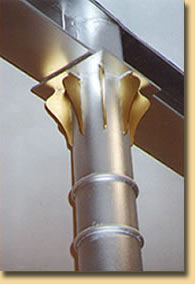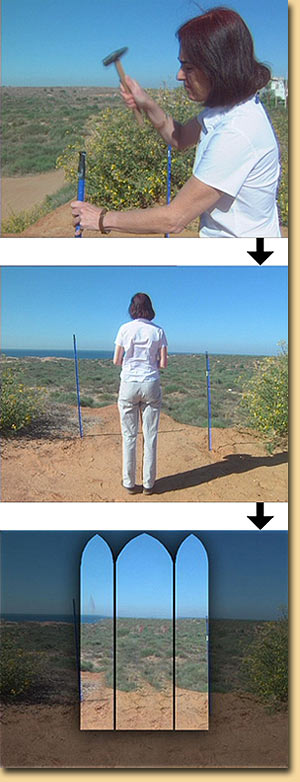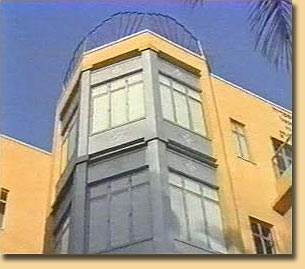![]()
 |
|
Architecture
Is Made For People There are different ways to describe buildings that have this timeless quality, buildings that convey an inherent spiritual experience. Frank Lloyd Wright called them “the ones which take you beyond words”. Quoted by Stephen Grabow, Christopher Alexander says: “The buildings that have spiritual value are a diagram of the inner universe, or the picture of the inner soul.” The basic argument
presented here is that in order to
change the feeling of the environment and create places and buildings
that we really feel part of and want to live in, what is needed is not
a change of style, but a transformation of the worldview underlying
current thought and approaches. |
| The Concept
Behind the Process A Holistic Approach to Architecture The holistic-organic worldview a worldview which stands in recent years at the forefront of the scientific discourse as a whole and is tightly related to the fundamentals of Buddhist teachings, guiding me in both theory and in practice, regards the socio-physical environment as a system or a dynamic whole, the existence of which depends on the proper, ever-changing interrelations among the parts. Moreover, the creation and existence of each part depend on the interrelations between that part and the whole His Holiness the Dalai Lama claims that understanding these expressions of dependent arising, cause and effect is condition for the realization of emptiness, being the foundation of all Buddhist teaching. In any organic system,
each element has its own
uniqueness and power, but always acts as part of a larger entity to
which it belongs and which it complements. Having adopted this concept,
I do not regard urban design, architecture, interior design and
landscape design as independent disciplines removed from each other,
but as one continuous and dynamic system. Thus the building is not
perceived as a collection of designed fragments, but as one
hierarchical language, in which every design detail, on any level of
scale, is derived from the larger whole to which it belongs, which it
seeks to enhance, and for whose existence it is responsible. |
 Essence of
harmony Essence of
harmony
Based on the assumption that beauty and harmony are objective properties related to the geometrical properties inherent in the structure itself, and that feelings have to do with facts, Alexander states that all places of organic order that seem unplanned and order less are a clear expression of order on a deep and complex level. This order is based on absolute rules that have always determined the quality and beauty of a place, and is the source of the good feeling in it. In other words, there is a direct connection between the pattern of events that occur in a place and the patterns of space that constitute it . Since we all share the
same comfortable feeling in that
environment which produces it, the explanation for that was, that as in
the various spoken languages there is,’ the language of
languages’ a common structural underlying patterns that are
innate in human beings and therefore common to us all, so in the
physical space there are patterns that reflect an innate pattern
structured in our brain .
|
|
The Planning Process The unique planning process presented here is fundamentally different from common ones. It allows the physical structure of the building to develop gradually from the living reality of the site itself, and provides the growth of an integral organic environment. As opposed to the common design process where the actual work start on the drawing board or the computer screen at the office and than superimposed on the site, here every planning decision grows out on the site itself, stemming from the direct experience of all the forces acting on the site. That whole which is experienced intuitively contains the climatic conditions, the angels of the view, the structure of the land and the features at the surrounding environment.
The decisions are marked on the ground by stakes, surveyed, and form the basic plan of the building and its outdoors.
The planning process is a transformational process from which the building and its outdoors are gradually unfolded. Each decision taken on the site is produced from the whole that exists at that moment on the site. In every step along the process a new structure-reality emerges, forming the base for the next decision. The design process on the site starts with decisions that are connected to the larger whole which exists at any certain moment, and continues with smaller decisions which spring from them and help to enhance them. For example: One of the first decisions is the location of the main gate to the site. That decision deals with the relationship between the site as a whole and it’s immediate surrounding, being the larger whole at that first moment of the procees. The following decision would deal with the position of the main entrance door to the building. That decision will be in direct relationship to the
new reality created after
having the entrance gate already located.
 The actual final building is a structure of balance between the patterns of the space and the environmental forces existing on the site. |
|
A Dialog
Between The
Qualities Of
Tradition
The potential inherent in a modern scientific technological society should honestly be used not as an aim by itself but as a tool for attaining human qualities and friendly environment. The
similarity and the association
created between the buildings I design and those we know from the past,
and the similar experience and feeling they create, originate in my use
of the same fundamental patterns and planning codes that guided in the
past, and will continue to guide in the future, in any culture and
tradition, those who aspire to give a building spirit and soul. |
| Film about the Design Approach & working process (The Director of the first 1.30 min is Sigal Weiss) (40Mb) |
 The
purpose of architecture, as I see it, is first and foremost to create a
human environment for human beings. Buildings affect our lives and the
fate of the physical environment in which we live over the course of
many years, and therefore their real test is the test of time. The fine
old buildings and places we always want to return to – those
with timeless relevance–are the ones that touch our hearts,
and have the power to create a deep and direct emotional experience .
The planning process proposed, is a process striving towards
phenomenological architecture that generates this spiritual experience
that is common to all people, no matter where or from what culture they
come from .
The
purpose of architecture, as I see it, is first and foremost to create a
human environment for human beings. Buildings affect our lives and the
fate of the physical environment in which we live over the course of
many years, and therefore their real test is the test of time. The fine
old buildings and places we always want to return to – those
with timeless relevance–are the ones that touch our hearts,
and have the power to create a deep and direct emotional experience .
The planning process proposed, is a process striving towards
phenomenological architecture that generates this spiritual experience
that is common to all people, no matter where or from what culture they
come from . The
dissociation created in our time between man and his environment is a
clear expression of the change that occurred in the concept that man is
part of nature and not superior to it . Comparing planning processes,
which resulted in dissociating man from his environment to planning
processes that make him feel part of the physical world he lives in,
emphasizes the difference between the mechanistic-fragmentary worldview
and the holistic-organic one.
The
dissociation created in our time between man and his environment is a
clear expression of the change that occurred in the concept that man is
part of nature and not superior to it . Comparing planning processes,
which resulted in dissociating man from his environment to planning
processes that make him feel part of the physical world he lives in,
emphasizes the difference between the mechanistic-fragmentary worldview
and the holistic-organic one. My
contention
is that the nature of the actual design process which creates an
environment is one of the crucial factors in determining whether the
environment will be of natural order and a pleasant place to live in.
My
contention
is that the nature of the actual design process which creates an
environment is one of the crucial factors in determining whether the
environment will be of natural order and a pleasant place to live in.
 The
quality
and uniqueness of the buildings I design follow an ongoing research the
aim of which is to integrate modern technology with timeless
architectural values which always gave and will give buildings their
true meaning and significance.
The
quality
and uniqueness of the buildings I design follow an ongoing research the
aim of which is to integrate modern technology with timeless
architectural values which always gave and will give buildings their
true meaning and significance.


